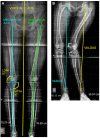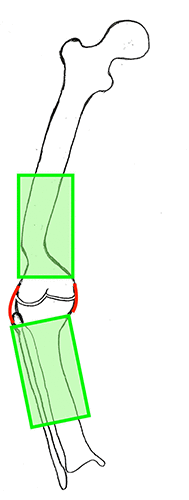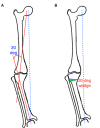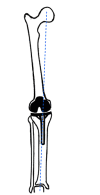Extra-articular deformities in arthritic knees-a grueling challenge for arthroplasty surgeons: An evidence-based update
- PMID: 29564077
- PMCID: PMC5850062
- DOI: 10.4081/or.2017.7374
Extra-articular deformities in arthritic knees-a grueling challenge for arthroplasty surgeons: An evidence-based update
Abstract
Critical to the success of a total knee arthroplasty (TKA) is the anatomical alignment. This may appear as a challenge in an extra-articular deformity (EAD) that may be inherent in certain people or result from fracture malunion, congenital disorders, nutritional, metabolic and infective causes. This appraisal aimed at providing the reader with an up-todate overview of the research carried out on, and existent evidence of EAD correction while planning a TKA. We reviewed the current English literature on TKA in extra-articular knee deformities. Among the published data, a common initial approach of mandatory clinical and radiological assessment emerges as an obligatory step while handling cases with EAD. While several methods of managing the deformity and arthritis have been described, a broad division into intra-articular and extra-articular means can be deciphered. The relatively old-school, yet reliable thought process of extra-articular correction allows an all-inclusive restoration of alignment with the inherent complications related to the necessary osteotomy. A cohort of younger and more venturesome surgeons seem inclined towards performing navigated, intra-articular correction for mild to moderate and sometimes, severe deformities. The crux of the matter lies is obtaining a well-balanced knee without violating the all-important cruciates. Restoring the patient's ambulatory status seems sooner with the intra-articular methods which are also more precise in determining the axes and while removing minimum bone. Greatest satisfaction is accomplished in those with less grotesque, rotationallyaligned knees while meticulously balancing soft-tissues and encouraging earlier weightbearing.
Keywords: complex total knee replacement; extra-articular deformities; intra-articular versus extra-articular correction; navigated total knee arthroplasty.
Conflict of interest statement
Conflict of interest: the authors declare that they have no conflict of interest
Figures






Similar articles
-
Surgical principles for complex primary total knee arthroplasty in the presence of extra-articular deformity.J Orthop. 2022 Sep 6;34:295-303. doi: 10.1016/j.jor.2022.08.017. eCollection 2022 Nov-Dec. J Orthop. 2022. PMID: 36164287 Free PMC article. Review.
-
Robotic-Assisted Total Knee Arthroplasty in the Presence of Extra-Articular Deformity.Surg Technol Int. 2019 May 15;34:497-502. Surg Technol Int. 2019. PMID: 30888672
-
Total knee arthroplasty in patients with Ranawat type-II valgus arthritic knee with a marked coronal femoral bowing deformity: comparison between computer-assisted surgery and intra-articular resection.J Orthop Surg Res. 2016 Aug 3;11(1):88. doi: 10.1186/s13018-016-0422-x. J Orthop Surg Res. 2016. PMID: 27488841 Free PMC article.
-
Simultaneous femoral osteotomy and total knee arthroplasty for treatment of osteoarthritis associated with severe extra-articular deformity.J Bone Joint Surg Am. 2000 Mar;82(3):342-8. doi: 10.2106/00004623-200003000-00005. J Bone Joint Surg Am. 2000. PMID: 10724226
-
Personalized total knee arthroplasty in patients with extra-articular deformities.EFORT Open Rev. 2024 Jul 1;9(7):646-657. doi: 10.1530/EOR-23-0215. EFORT Open Rev. 2024. PMID: 38949174 Free PMC article. Review.
Cited by
-
Surgical principles for complex primary total knee arthroplasty in the presence of extra-articular deformity.J Orthop. 2022 Sep 6;34:295-303. doi: 10.1016/j.jor.2022.08.017. eCollection 2022 Nov-Dec. J Orthop. 2022. PMID: 36164287 Free PMC article. Review.
-
Simulation of osteotomy in total knee arthroplasty with femoral extra-articular deformity assisted by artificial intelligence: a study based on three-dimensional models.J Orthop Surg Res. 2024 Oct 10;19(1):641. doi: 10.1186/s13018-024-05126-8. J Orthop Surg Res. 2024. PMID: 39385180 Free PMC article.
-
Single-stage total knee arthroplasty and femoral osteotomy for osteoarthritis with severe supracondylar deformity.J Orthop Surg Res. 2021 Feb 20;16(1):149. doi: 10.1186/s13018-021-02293-w. J Orthop Surg Res. 2021. PMID: 33610184 Free PMC article.
-
Accelerometer-Based Navigation versus Conventional Total Knee Arthroplasty for Posttraumatic Knee Osteoarthritis.Clin Orthop Surg. 2022 Dec;14(4):522-529. doi: 10.4055/cios21147. Epub 2022 Apr 27. Clin Orthop Surg. 2022. PMID: 36518940 Free PMC article.
-
Staged Extra-Articular Deformity Correction in the Setting of Total Knee Arthroplasty.Arthroplast Today. 2023 Nov 9;24:101247. doi: 10.1016/j.artd.2023.101247. eCollection 2023 Dec. Arthroplast Today. 2023. PMID: 38023645 Free PMC article.
References
-
- Shan L, Shan B, Suzuki A, et al. Intermediate and long-term quality of life after total knee replacement: a systematic review and meta-analysis. J Bone Joint Surg Am 2015;21;97:156-68. - PubMed
-
- Eymard F, Charles-Nelson A, Katsahian S, et al. Forgotten knee after total knee replacement: A pragmatic study from a single-centre cohort. Joint Bone Spine 2015;82:177-81. - PubMed
-
- Moreland JR. Mechanisms of failure in total knee arthroplasty. Clin Orthop Relat Res 1988;:49-64. - PubMed
-
- D’Lima DD, Chen PC, Colwell CW Jr. Polyethylene contact stresses, articular congruity, and knee alignment. Clin Orthop Relat Res 2001:232-8. - PubMed
LinkOut - more resources
Full Text Sources
Other Literature Sources

